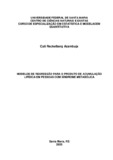| dc.contributor.advisor | Moraes, Anaelena Bragança de | |
| dc.creator | Azambuja, Cati Reckelberg | |
| dc.date.accessioned | 2021-04-14T21:16:34Z | |
| dc.date.available | 2021-04-14T21:16:34Z | |
| dc.date.issued | 2020-04 | |
| dc.date.submitted | 2020 | |
| dc.identifier.uri | http://repositorio.ufsm.br/handle/1/20570 | |
| dc.description | Monografia (especialização) - Universidade Federal de Santa Maria, Centro de Ciências Naturais e Exatas, Curso de Especialização em Estatística e Modelagem Quantitativa, RS, 2020. | por |
| dc.description.abstract | The aim of the study was to analyze the relationship between anthropometric variables: waist circumference (WC), hip circumference (HC), body mass (BM), height (HGT) and hemodynamic variables: systolic (SBP) and diastolic (DBP) blood pressure with the lipid accumulation product (LAP), and describe a mathematical model that best represented it. Data from 430 subjects of both sexes, who presented at least three risk factors for Metabolic Syndrome (MetS) concomitantly, were analyzed, according to the recommendations of the Third Report of the National Cholesterol Education Program Expert Panel on Detection, Evaluation and Treatment of High Blood Cholesterol in Adults (NCEP-ATPIII). Descriptive statistical analysis was performed, followed by regression analysis, using the stepwise and enter methods to adjust the multiple linear regression model (MRL). The dependent variable for the MLR model was the LAP, and the predictor variables were WC, BM, HC, DPB, SBP and HGT. In the model obtained by the stepwise method, the percentage of explanation for LAP variation was 42% and the explanatory variables are WC (b = 1.946; p ≤ 0.001), DBP (b = 0.540; p ≤ 0.001) and HC (b = -0.594; p = 0.002). In the model generated by the enter method, the percentage of explanation for LAP variation was 39%, and the explanatory variables are WC (b = 1.567; p ≤ 0.001) and the DBP (b = 0.547; p ≤ 0.001). Therefore, the regression model that best described the relationship between anthropometric and hemodynamic variables with the LAP was that generated by the stepwise method. For the purpose of identifying a more simplified method of initial screening to detect likely candidates for the development of MetS, despite the limitations in the predictive power in the LAP variation, it is considered that the chosen model satisfies the need, from an analysis that also involved the health sciences. | eng |
| dc.language | por | por |
| dc.publisher | Universidade Federal de Santa Maria | por |
| dc.rights | Acesso Aberto | por |
| dc.rights | Attribution-NonCommercial-NoDerivatives 4.0 International | * |
| dc.rights.uri | http://creativecommons.org/licenses/by-nc-nd/4.0/ | * |
| dc.subject | Modelo matemático | por |
| dc.subject | Método stepwise | por |
| dc.subject | Doenças cardiometabólicas | por |
| dc.subject | Mathematic model | eng |
| dc.subject | Stepwise method | eng |
| dc.subject | Cardiometabolic diseases | eng |
| dc.title | Modelos de regressão para o produto de acumulação lipídica em pessoas com síndrome metabólica | por |
| dc.title.alternative | Regression model for the lipid accumulation product in people with metabolic syndrome | eng |
| dc.type | Trabalho de Conclusão de Curso de Especialização | por |
| dc.degree.local | Santa Maria, RS, Brasil | por |
| dc.degree.specialization | Estatística e Modelagem Quantitativa | por |
| dc.description.resumo | O objetivo do estudo foi analisar a relação entre variáveis antropométricas: circunferência da cintura (CC), circunferência do quadril (CQ), massa corporal (MC), estatura (EST) e variáveis hemodinâmicas: pressão arterial sistólica (PAS) e diastólica (PAD) com o produto de acumulação lipídica (PAL), e descrever um modelo matemático que melhor a representasse. Foram analisados dados de 430 sujeitos, de ambos os sexos, que apresentaram ao menos três fatores de risco para o diagnóstico da Síndrome Metabólica (SMet) de forma concomitante, conforme as recomendações do Third Report of the National Cholesterol Education Program Expert Panel on Detection, Evaluation and Treatment of High Blood Cholesterol in Adults (NCEP-ATPIII). Foram realizadas a análise estatística descritiva seguida da análise de regressão, sendo considerados os métodos stepwise e enter para o ajuste do modelo regressão linear múltipla (RLM). A variável dependente para o modelo de RLM foi o PAL sendo as variáveis previsoras, a CC, a MC, a CQ, a PAD, a PAS e a EST. No modelo obtido pelo método stepwise, o percentual de explicação foi de 42% e as variáveis preditoras foram: CC (b = 1,946; p ≤ 0,001), PAD (b = 0,540; p ≤ 0,001) e CQ (b = - 0,594; p = 0,002). No modelo gerado pelo método enter, o percentual de explicação foi de 39%, e as variáveis preditoras foram: CC (b = 1,567; p ≤ 0,001) e a PAD (b = 0,547; p ≤ 0,001). Portanto, o modelo de regressão escolhido para descrever a relação entre as variáveis antropométricas e hemodinâmicas com o PAL foi o gerado pelo método stepwise. A partir do propósito de identificar um método mais simplificado de triagem inicial para detectar prováveis candidatos ao desenvolvimento da SMet, mesmo diante de limitações no poder de predição na variação do PAL, considera-se que o modelo escolhido satisfaz a necessidade, a partir de uma análise que também envolveu as ciências da saúde. | por |
| dc.publisher.country | Brasil | por |
| dc.publisher.initials | UFSM | por |
| dc.subject.cnpq | CNPQ::CIENCIAS EXATAS E DA TERRA::PROBABILIDADE E ESTATISTICA | por |
| dc.publisher.unidade | Centro de Ciências Naturais e Exatas | por |



